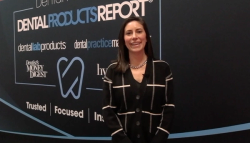- About Us
- Advertise
- Editorial
- Contact Us
- Terms and Conditions
- Privacy Policy
- Do Not Sell My Personal Information
© 2025 MJH Life Sciences™ and Dental Products Report. All rights reserved.
International Dental Show 2023 – Day 3 Recap
Attempting to take in all of the 2023 International Dental Show is both challenging and rewarding, as new products and innovative concepts abound throughout the world's largest dental products exhibition.
With close to 2000 exhibitors on hand from around the globe, seeing all of the 2023 International Dental Show (IDS) is a massive, multi-day effort as the world's largest dental trade exhibition is filled with the latest ideas and innovations for dental professionals.
After several days of walking the exhibit halls, dental product trends begin to take shape. For IDS 2023 these include the expansion of intraoral scanning options, the rapid growth of 3D printers and materials, and leveraging artificial intelligence (AI) to create clinical and production efficiencies. Another trend emerging from the show is a focus on sustainability which can bring numerous benefits including savings in cost, time, and of course the reduction of waste.
Carbon Creates Efficiencies With New Model Material
Carbon continued to focus on helping dental labs increase productivity with 3D printing as the company showed off its next generation of clear aligner model resin. The new resin produces hollow models that retain the strength necessary for thermoforming clear aligners, but uses 40% less material than the previous generation of Carbon 3D printed models.
The new model workflow, which allows a Carbon printer to increase its throughput by 65%, takes advantage of advancements in both material chemistry and software to plan a hollow interior while retaining the same exterior accuracy. The hollow models are produced without the need for a solvent, and uncured resins are returned to the tank for future model production.
While the new material will allow clear aligner producers to increase capacity and improve efficiencies, officials from Carbon are also focused on dental labs looking to print nightguards, dentures, and other dental appliances and restorations. The company sees 3D printing as driving both increased productivity for digital dental labs as well as more sustainable workflows that generate less waste.
Steiriliu Launches VisionButler Reusable Retractor
Innovative organization company Steiriliu is building on its portfolio of silicone bur blocks and organization systems with the addition of the VisionButler, a soft silicone lip and cheek retractor that can be autoclaved up to 1000 times. The reusable retractor is soft, and comfortable for patients while being simple to place.
The retractor's black color provides contrast for clinical photography and it can also be used while capturing clinical images, whitening teeth, or when managing orthodontic and prophy patients. As a reusable device, VisionButler can help reduce a practice's waste while saving money by reducing the need for disposable retraction solutions.
Shining 3D Dental Announces Wireless Intraoral Scanner Along With 3D Face Scanner
The Shinning 3D booth was a busy place as the growing digital dentistry company showed a pair of new innovations. The Aoralscan 3 Wireless brings even more flexibility to the company's intraoral scanning solutions, while the MetiSmile 3D Face Scanner.
The new intraoral scanner model features WiFi 6 technology for fast and stable data connections, while the battery can provide up to 2 hours of continuous scanning on a single charge. Two tip sizes are available, and the scanner software uses AI to enhance model creation and streamline scanning workflows.
The new MetiSmile is the company's first extraoral face scanner, and the unit is designed for multiple clinical applications. The scanner can automatically align extraoral and intraoral scan data to create a complete 3D patient model that can be used for a range of tasks including orthodontic simulation, facial feature measurement, and dynamic occlusion measurement.
HASS Shows Its Latest CAD/CAM Blocks for Abutment Crowns
The latest millable blocks from HASS are the Amber® MIll Meso, which are made from lithium disilicate and designed for fabricating implant crowns and abutments.
Compatible with Dentsply Sirona's TiBase system, the blocks feature variable translucency, and they are indicated for use as custom abutments or implant crowns in both the anterior and the posterior.
TSpro Demonstrates Vacuum Connects Tongue Cleaning System
German company TSpro was on hand demonstrating its TS1 Tongue Vacuum Cleaner solution. While the product is not yet available in the US, it works by connecting a small plastic head to the dental suction line. A cleansing gel is rubbed onto the tongue with a nubbed side of the TS1, and then the device is flipped over so the vacuum side can be used to clean a patient's tongue.
The simple solution is designed to remove oral bacteria that can build up on the tongue, and after a professional vacuum cleaning, the TS1 can be removed from the suction line, rinsed, and attached to a homecare handle so the patient can take the cleaner home and continue to maintain tongue hygiene at home.
Lithoz and Ivoclar Partner for 3D Printing With Lithium Disilicate
Ceramic 3D printing company also had a new innovation that is not yet ready to launch in the United States, 3D printing in lithium disilicate. The company is developing the material and workflow in partnership with Ivoclar and hope to launch the solution for practices and labs in the US sometime in 2024.
Designed for the printing of glass-ceramic veneers and crowns, the solution can be used to print up to 100 individual restorations at a time and can greatly reduce material waste while making it easier for labs to consistently produce precise, thin restorations.



